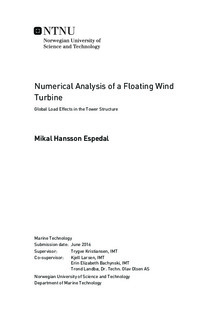Numerical Analysis of a Floating Wind Turbine - Global Load Effects in the Tower Structure
Master thesis
Permanent lenke
http://hdl.handle.net/11250/2614993Utgivelsesdato
2016Metadata
Vis full innførselSamlinger
- Institutt for marin teknikk [3432]
Sammendrag
The OO Star 10 MW is a semi-submersible floater that aims to support a 10 MW wind turbine.It consists of three outer columns with a shaft in the centre. The floater is designedto be built from concrete, and a steel tower is mounted on top of the concrete shaft providing a sufficient height for the wind turbine. Bottom part of the steel tower is sensitive to fatigue damage, even though steel thickness is close to both a practical and economical limit. A study of the effect on fatigue damage when increasing concrete shaft length is therefore performed.
Three cases with variable concrete shaft length are tested. The cases are named Case 0,Case 20 and Case 40. The number at each case represents increased concrete shaft lengthin metre compared to a base case. Small geometry modifications are done on Case 20and Case 40 to maintain sufficient stability. Also the steel towers are slightly stiffer atcomparable vertical positions for Case 20 and Case 40 compared to Case 0. Wind turbineis taken as the 10 MW DTU reference turbine, and hub height is kept constant for all threecases.
The problem is solved in time domain by use of the software SIMA. SIMA uses hydrodynamicforces calculated in the software Wadam and a turbulent wind field created by thesoftware TurbSim. Calculations are performed for severe environmental conditions, andstress is calculated at several vertical positions on the steel tower. Stress concentration and safety factors are taken in accordance with regulations. Fatigue damage is estimated byuse of a S-N curve.
A sensitivity study showed that first bending mode frequency for the steel tower is dependingon the water plane stiffness, and that it is increased when the tower is mounted on afloater compared to being fixed. For current designs, this is found to be critical. All threecases have steel tower eigenfrequency close to the blade passing frequency (3p).
Contributions to fatigue is found to be wind, wave and 3p forces, where the latter onegives the largest contribution. Preliminary results show that an increased concrete shaftwill improve fatigue life time, but due to the large 3p effects, none of the three designshave a sufficient life time. The fatigue life time is found to be 1.2 years for Case 0, 1.32years for Case 20 and 1.39 years for Case 40. Fatigue life time for Case 40 is estimatedto increase to 12.5 years if 3p effects are minimized. In addition to improving fatigue lifetime, an increase of concrete shaft with 40 metre will reduce the material cost by 5 mNOK.
Fatigue life time must be improved, and it is therefore recommended to modify the steeltower such that eigenfrequency is outside the 3p frequency range. Also using a steel towerwith variable bending stiffness at different angular positions is found to be an option.
Additional design aspects were tested for Case 0 to be used in a screening process. Resultsindicate that mooring line tension, horizontal offset, pitch motion, acceleration at hubheight and air gap is within requirements. Freeboard at outer column is found to be criticallow, and the column risks being fully submerged during critical environmental conditions.
